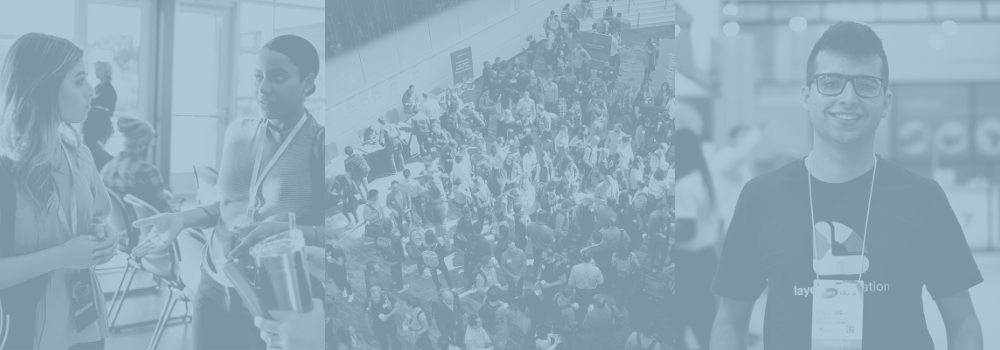community involvement | tech community | Culture | Conferences
So, you’ve decided to go to a conference. Great! This is the perfect opportunity to immerse yourself in an environment that allows you to thrive in your career. Whether you’re looking for tips to overcome networking nervousness or need some help to fine-tune your conferencing skills, there are a bunch of situations and scenarios that we can help you navigate with ease — we’ve got some experience!
Meagan Anderson, Project Manager at Aviture, along with Art Doler, Community and Culture Steward and Senior Software Developer, are here to help guide and provide tips for various conference networking scenarios.
1. Conferences Are for Learning “About”
When you go to conferences, there will usually be breakout sessions allowing you to learn about new techniques, libraries, technology, and more. The tradeoff is that most of these hour-long sessions are typically written from an introductory perspective. After all, you can only cover so much in an hour! Since these sessions don’t really dive as deep as you might want to get into the topic, you shouldn’t expect to gain a deep proficiency — so the next best option is to cast your net wide across all the breakout sessions and find other topics you might be interested in.
“Go to that talk on the language you haven’t learned yet. Go to the talk on the framework you saw a blog post about one time. Go to the talk about how to pair program well. Go to the talk about brains given by that one weird guy. Use the short time frame as a chance to explore things you’ve never considered before; or to find out why you would use a certain tool, or even as a way to gain a different viewpoint on something you already know.”
- Art Doler
After you’ve left the conference and the sessions behind, it’s the perfect time to digest what you have taken in — or even ignore what you didn’t like! Just because you attended a session doesn’t mean that you’re required to remember or pursue every aspect that was discussed. Either way, you had the opportunity to explore something new. Now you can go deeper into the things you like and ignore the things you didn’t.
2. Access to the Experts
Breakout sessions mean speakers, and speakers mean insights. Those who speak on specific topics may not be the world’s foremost experts on the topic, but the effort, time, and research that was put in to construct the talk make them great people to have a conversation about the topic with.
“So have conversations with the speakers whose talks you liked! Don’t be afraid to engage with them; access to the speakers is part of the cost of your ticket to the event. Ask them questions in their talks, or if you’re at the same table at lunch, or if you bump into them at the attendee party. Having deeper conversations with attendees is an expected part of the speakers' participation in the conference… and to be completely honest, it’s usually our favorite part of the conference, too.”
- Art Doler
Remember, these speakers are human too. You don’t want to take up all of their time, but speakers are knowledgeable and valuable resources. Whether it’s a general question or a specific scenario happening at work (or in your life, depending on the speaker) it gets both you and the speaker thinking and can give you an even better conference experience.
If you find yourself in a situation where you might feel uncomfortable engaging, remember to stay confident!
“Any woman who has been in the field for a few years, probably has her own story about how she was mistaken for a recruiter or HR, must only be a designer, felt the need to set ground rules when supplying contact information, was ignored in a crowd of men or has been talked over because what she’s saying is seeming unimportant. The key is to stay confident, you belong here, just like everyone else and you have the knowledge and skills necessary to be relevant in the room.”
- Meagan Anderson
3. The Hallway Track
Any person at the conference, attendee, speaker, or organizer, can be the source of a valuable conversation. If you find yourself getting deep into a chat with someone, don’t feel like you need to abandon that conversation just to make it to a session you aren’t that interested in! This is often called the “Hallway Track” since conferences will often group similar talks into one room and call it a “track” — an example of this is the Human Skills track at the Kansas City Developer Conference (KCDC). While chatting with other attendees might seem like you’re wasting your time at the conference, this space can end up being quite valuable.
“The Hallway Track can be just as valuable as some of the other tracks at a conference, and sometimes more valuable, because it helps you build both professional and personal relationships with others in the same industry. Or even just a human connection with a new and future friend.”
- Art Doler
These connections are valuable to you, so don’t shy away from getting lost in a conversation with someone else.
4. Lower Your Shields
If we understand that part of the value of conferences is the interaction, then it’s important to realize that every one of us is carrying around our own personal social shield without sometimes even realizing it: a thing that helps protect us from others' words and attention. When we’re using it, we’re in our own little bubble, and other people — consciously or otherwise — avoid breaking into it. What is this magical device, you might ask?
It’s your phone.
Scrolling through Twitter, checking your email, doing your daily missions on that hot new mobile game, whatever your particular flavor of digital engagement is, doing that at a conference is a huge signal to others that we don’t want to be bothered. So, when you’re sitting at a table at lunch, or hanging out at the attendee party, resist the urge to pull out your phone!
"Unless you’re capturing the moment with your new connections, the most important part of networking is to 'be here now.' Each interaction you have with someone can be fruitful. Keeping yourself open to face-to-face interactions may land you a potential partnership or business lead, a chance to share your experience, a connection to someone with exactly the type of talent your team needs, or the opportunity to connect with someone with a similar role. Even if the interaction doesn’t bring you something you can use later, each time you initiate or participate in these exchanges, you become more confident in yourself and the message you want to convey — and may even make yourself more relevant in your field.”
- Meagan Anderson
This doesn’t mean that phones are completely off-limits though. Pull them out to connect on LinkedIn, get a fun picture of you and maybe a new friend at a booth, or connect with that cool company you saw who wants your info — just don’t forget to show that there’s a person behind that shield.
5. Golden Conversation Starters Meets The Pac-Man Rule
Small talk may just seem like a mundane human behavior that you have to do when you’re in a room full of people who are there for the same thing you are. At a conference, you have something working in your favor — being in the room with like-minded humans who can help fill your craft.
Take advantage of sitting next to that stranger at lunch or in the breakout session before it starts. “So, what do you do?”, “Where do you work?”, “What sessions did you attend?”. These small bits of conversation will kindle a conversation that can lead to a connection.
When you finally get a conversation going, in a hallway, at the attendee party, maybe even during lunch or happy hour — you want to make sure that your conversation is open. After all, the more people you get jumping in, the more connections you’ll make and the more interesting that conversation can get!
There’s one fun trick you can use to ensure that someone always feels like they can join in: The Pac-Man Rule.
People having conversations without furniture involved often naturally assume the form of a loose circle:

The Pac-Man Rule says that you always leave a little spot open for someone to join, so your circle instead looks more like Pac-Man:

When someone walks in to fill the spot, you reshuffle the circle and make it a little larger, so there’s still an empty spot open. This way, you’re always extending an invitation for someone new to join in on the fun! Seriously, try it out — you’d be surprised how effective it can be sometimes.
6. Standing Out at a Conference (In a Good Way)
When you’re getting dressed for the conference, you should keep your goals in mind. Are you just there for the talks and the learning? Your stereotypical t-shirt and jeans are probably best. Are you looking to stand out? A sharp suit, a dazzling dress, or some other kind of outstanding outfit might go a long way, as long as you’re comfortable in it. The key is to keep impressions in mind: if you’re wearing a sleeveless tank top and sweatpants, people might think you sleepwalked to the venue. You don’t need to be super dressed up to have great conversations, but you might not want to wear your pajamas. Don’t overthink it!
“If we’re talking about clothes, I feel obligated to include one of my own personal conference rules. Conferences often hand out t-shirts to attendees when they register the first day - don’t wear that shirt the next day! A lot of other people are going to be wearing it, so it will make you blend in instead of standing out. Beyond that, it’s the same energy as someone wearing the current t-shirt for a band’s tour at the show - it just really radiates “excited newbie” energy.”
- Art Doler
If you’ve been to a conference multiple times you can wear previous years' shirts. It’s a great way to bond with someone else wearing the same shirt since you can both be hipsters about how long you’ve been attending. That sounds like a joke, but it’s not — it works well as a conversation starter.
7. Be an Advocate
Everyone, regardless of gender, who attends a conference is in this world and this field together. Good experiences should be celebrated, and when bad ones happen they should be addressed. If you experience or overhear something that seems to be drowning in bias, is overtly stereotypical, or is making the recipient or yourself obviously uncomfortable, you can help facilitate that crucial conversation by asking why that person made that presumption. If you see someone breaking the code of conduct of the conference, report it to the organizers.
“It’s easy to shut down and feel feels when these bad interactions happen. I know this is easier said than done but make sure you share your experience with your team or allies in the room and take it as a learning experience. Now you know what people are capable of throwing at you and now you have practice overcoming it! Remember, it’s not personal, and these actions/thoughts usually have nothing to do with who you are or what you’re capable of.”
- Meagan Anderson
You can be that person who steps up to make a connection through conversation to encourage a positive outcome. It might take some practice and it can be scary sometimes but remember to stay confident.
8. Don’t Disrespect Newbies
“At literally every conference I have attended, a good percentage of the folks there are experiencing their first developer conference ever.”
- Art Doler
New developers are important - tech is still a hugely growing field, and the craft of programming is slowly seeping outwards into more and more industries and job types. So don’t talk trash about someone or exclude them just because they’re new to the field, or have a nontraditional background, or even if they’re very, very excited (maybe TOO excited…) to be there. They deserve to learn and connect and grow too, and you should give them a chance.
“I feel energized just by being at conferences and go out of my way to engage with attendees, especially those who seem to be the newbies in the crowd. Being someone who has a smaller role in the development world, is maybe a little TOO excited AND has a nontraditional background, I love engaging with anyone who wants to compare notes and can sympathize with those who may feel ostracized.”
- Meagan Anderson
This is your chance to be an advocate and an awesome hype person! Get them excited about sessions, who the speakers are, and what they can expect from the experience — don’t be afraid to Pac-Man rule them in! Those who have done this before are in the perfect position to guide them toward great opportunities.
Wrapping Up
Conferences can literally change your career — a talk you decide to go to at the last minute or a chance encounter can send you off on an entirely new trajectory. Even if you don’t experience that dramatic a change, conferences can still be great places to recharge your love of software — or to find it for the first time. Hopefully, with these tips, you can make the most of your time there!
About Meagan Anderson & Art Doler
Meagan has worked in various industries and has more than 10 years and lots of flavors of leadership and management behind her. She enjoys building relationships to further bolster her pipeline for knowledge transfer. She is passionate about social engagement, team empowerment, solving big problems, and professional growth for all! Arthur (or Art, take your pick) has been a software engineer for 19 years. He is an advocate for talking openly about mental health and psychology in the technical world, and he spends a lot of time thinking about how we program and why we program, and about the tools, structures, cultures, and mental processes that help and hinder us from our ultimate goal of writing amazing things.




